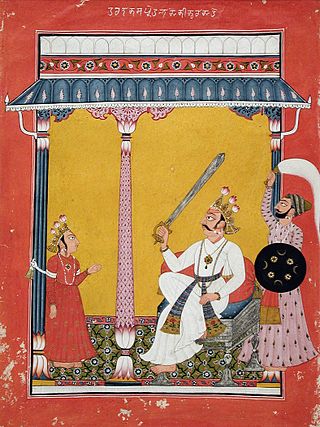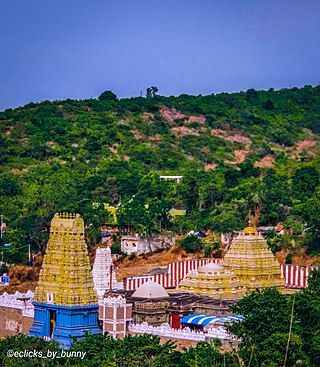
Hiranyaksha, also known as Hiranyanetra was an asura as per Hindu mythology. He is described to have submerged the earth and terrorised the three worlds. He was slain by the Varaha avatar of Vishnu, who rescued the earth goddess Bhumi and restored order to the earth.

Narasimha, sometimes rendered Narasingha, is the fourth avatar of the Hindu god Vishnu. He is believed to have incarnated in the form of a part-lion, part-man being to kill Hiranyakashipu, to end religious persecution and calamity on earth, thereby restoring dharma. Narasimha is often depicted with three eyes, and is described in Vaishnavism to be the God of Destruction; he who destroys the entire universe at the time of the great dissolution (Mahapralaya). Hence, he is known as Kala (time) or Mahakala (great-time), or Parakala in his epithets. There exists a matha (monastery) dedicated to him by the name of Parakala Matha at Mysuru in the Sri Vaishnava tradition. Narasimha is also described as the God of Yoga, in the form of Yoga-Narasimha.

Hiranyakashipu, also known as Hiranyakashyap, was a daitya king of the asuras in the Puranas.

Vamana also known as Trivikrama, Urukrama, Upendra, Dadhivamana, and Balibandhana, is an avatar of the Hindu deity Vishnu. He is the fifth avatar of Vishnu and the first Dashavatara in the Satya Yuga, after Narasimha.

Dhanvantari is the physician of the devas in Hinduism. He is regarded as an avatar of Vishnu. He is mentioned in the Puranas as the god of Ayurveda.

Sri Varaha Lakshmi Narasimha temple, Simhachalam, is a Hindu temple situated on the Simhachalam Hill Range,which is 300 metres above the sea level in the city of Visakhapatnam, Andhra Pradesh, India. It is dedicated to Lord Vishnu, who is worshipped there as Varaha Narasimha. As per the temple's legend, Vishnu manifested in this form after saving his devotee Prahlada from a murder attempt by the latter's father Hiranyakashipu. Except on Akshaya Trutiya, the idol of Varaha Narasimha is covered with sandalwood paste throughout the year, which makes it resemble a linga. The temple was built in Kalingan architecture styles and stands unique in the historical region of Kalinga.The Present temple was built by Eastern Ganga king Narasingha Deva I in the 13th century and consecrated by his son Bhanudeva I in 1268 CE. The temple was built by Akthayi Senapati, on the command of Narasingha Deva I.

Holika, also known as Simhika, is an asuri in Hinduism. She is the sister of the asura-kings Hiranyakashipu and Hiranyaksha, and the paternal aunt of Prahlada.

Kollur Mookambika Temple is located at Kollur in Byndoor Taluk of Udupi District in the region of Tulunadu and in the state of Karnataka, India. It is a Hindu temple dedicated to the Mother Goddess known as Mookambika Devi. Mookambika is the union of Adipara Shakthi and Parabramha as the Linga has integrated on its left side "Maha Kali, Maha Lakshmi and Maha Saraswathi". The temple is very special because it is part of the 108 Durgalayas and 108 Shivalayas. It is situated in the foothills of Kodachadri hills, on the southern bank of Souparnika River. Being situated in the land between Gokarna and Kanyakumari, believed to be created by sage Parashurama.

Kuravilangad is an Indian town located in the northern part of the Kottayam district in Kerala. It is situated in the Meenachil taluk, about 22 km north of the district capital Kottayam and 17 km west of the municipal town Pala.
Vishnu Puran is an Indian television series, by B. R. Chopra on the Hindu deity Vishnu. It is based on the Bhagavata Purana. Bhagavata Purana tells about the 10 incarnations of Vishnu, as well as other stories, such as the legend of Dhruva. The weekly series first aired Sunday morning, 23 January 2000 on Zee TV. The 124 episodes were later released on DD National.

Chenchu Lakshmi is a 1958 Indian Telugu-language Hindu mythological film produced and directed by B. A. Subba Rao. It stars Akkineni Nageswara Rao and Anjali Devi, with music composed by S. Rajeswara Rao. Along with the Telugu version, it was simultaneously shot in Tamil, with most of the actors and scenes being the same in both the versions. Another Chenchu Lakshmi was earlier made in 1943 with a different cast and crew.

Prahlada is an asura king in Hindu mythology. He is known for his staunch devotion to the preserver deity, Vishnu. He appears in the narrative of Narasimha, the lion avatara of Vishnu, who rescues Prahlada by killing his wicked father, Hiranyakashipu.

The Janardanaswamy Temple, also known as the Varkala Temple, is a Hindu temple situated in Janardhanapuram, Varkala city, of the Thiruvananthapuram district. A renowned temple within its locale, the temple is thousands of years old. The temple is dedicated to the worship of deity Vishnu in the form of Janardanaswamy, locally known as Varkaleswara.

Narasimha Jharni Temple, also known as Narasimha Jharni cave temple, is a temple located in Malkapur Road, NH 161B, Mangalpet, Pakalwada, Bidar - 585401, Karnataka. It is associated with Lord Narasimha, an incarnation (avatar) of the Hindu god Vishnu. The ancient temple is excavated in a 300 m tunnel under the Manichoola hill range situated at around 4.8 km from the city. The temple is Classified as one of the 108 Abhimana Kshethram of Vaishnavate tradition.

Padalathri Narasimhar Temple or Narasimhar Temple is dedicated to Hindu god Vishnu (Narasimha) located in Singaperumal Koil, near Chennai City, in the South Indian state of Tamil Nadu. Constructed as rock-cut architecture, dedicated to Vishnu, who is worshipped as Narasimhar, and his consort Lakshmi as Ahobilavalli, the temple was built by the Pallavas during the 8th century. Earlier in Kanchipuram district, it is now under Chengalpattu district. The temple is Classified one among the 108 Abhimana Kshethram of Vaishnavate tradition.

The Alagiyasingar Temple in Thiruvali, a village in Mayiladuthurai district in the South Indian state of Tamil Nadu, is dedicated to the Hindu god Vishnu. Constructed in the Dravidian style of architecture, the temple is glorified in the Nalayira Divya Prabandham, the early medieval Tamil canon of the Alvar saints from the 6th–9th centuries CE. It is one of the 108 Divya Desams dedicated to Vishnu, who is worshipped as Alagiyasingar and his consort Lakshmi as Purnavalli.

Namakkal Anjaneyar temple is located in Namakkal, a town in Namakkal district in Tamil Nadu, India and is dedicated to the Hindu god Hanuman. It is constructed in the Tamil style of architecture. The legend of the temple is associated with Narasimha, an avatar of Hindu god Vishnu appearing for Hanuman and Lakshmi. The image of Anjaneyar is 18 ft (5.5 m) tall, making it one of the tallest images of Hanuman in India. The temple follows the Vaikhanasa tradition.

Abaya Hastha Swayambu Sri Lakshmi Narasimha Swamy Temple is a holy Hindu religious site in the village of Agaram Agraharam in Hosur taluk of Krishnagiri district in the Indian state of Tamil Nadu. It is located 15 km from Hosur on Rayakotta Road and 65 km from Bangalore.

The Senji Singavaram Ranganatha Temple is a cave-temple in India dedicated to God Ranganatha and Goddess Ranganayaki Thayar. The temple is a Pallava period structure, and was reconstructed and patronized by Krishnapa Nayakkar of Senji Nayak dynasty..

Narasimha Jayanti is a Hindu festival that is celebrated on the fourteenth day of the Hindu month of Vaisakha (April-May). Hindus regard this as the day the deity Vishnu assumed his fourth avatar in the form of a "man-lion", known as Narasimha, to vanquish the oppressive asura king Hiranyakashipu and protect his devotee Prahlada. The legend of Narasimha represents the victory of knowledge over ignorance and the protection offered by God to his devotees.



















